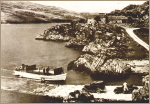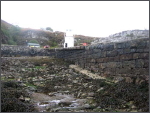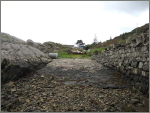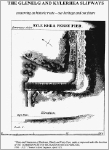Ferry House: the Glenelg-Kylerhea ferry
Historic ferry to Skye—still working today

The Kylerhea Ferry is the first recorded ferry to Skye and is mentioned by Martin Martin in his journal of his tour of Skye in the 1630s. This was also the drove route by which cattle were taken to and from Skye to market in Central Scotland. Today's ferry operates in the summer months and is, as far as we know, the only manual turntable ferry in the world.
The sepia photo of the ferry on the right was taken in the 1920s or 30s and shows the Ferry House in the background.
The slipway at Glenelg is built of dressed stone blocks with stone sets on the surface and it was designed by Thomas Telford.
The site at Glenelg we believe to be unique in that it has a cattle slip.
Telford was keen to support the cattle trade, it being the key to the Highland economy. Some estimates consider that as many as 8000 cattle crossed here annually. Telford calculated that about £6000 was saved per year by using this crossing as part of his road system from Portree through to Glengarry.
The slipway on the Skye side was also built by Telford. In the nineteenth century, crofters on this side had their rents reduced in return for working the ferry - they were paid 6d for every head of cattle ferried, half of which went to the innkeeper!
We are hoping to gain funding to have these historic slipways sustainably restored. This would help to secure the future of the ancient ferry crossing and also provide the community and the visitor with a tangible link to the past.
For more information about Ferry House, please write to:
James Watt,
Ferry House,
Glenelg, IV40 8JZ,
Telephone 01599 522 253
or email: holidays@ferryhouse.co.uk



